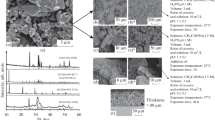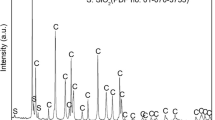Abstract
Hydroxyapatite (Ca10(PO4)6(OH)2) ceramic sheets with a wide range of porosities (up to 62%) have been prepared. The process is based on the reaction between dicalcium phosphate (CaHPO4) and calcium carbonate (CaCO3). When mixed with the appropriate Ca/P ratio, this proves to be a reliable new method for obtaining hydroxyapatite. Moreover, CaCO3 serves as a gas-forming agent (due to the evolution of carbon dioxide and water during the reaction), which leads to the development of highly porous microstructures. Alternatively, CaHPO4 and CaCO3 can be reacted by calcining at 1000°C to produce pure hydroxyapatite powders. When processed in a similar way, a dense ceramic results. By mixing 50 vol% of CaCO3 and CaHPO4 with precalcined powders, hydroxyapatite with an intermediate porosity was obtained. Moreover, it should be possible to achieve porosity control by mixing different amounts of uncalcined and precalcined powders. All of these powders are colloidally processed using tape casting to produce thin sheets 150–200 μm thick. This technique can be used to make laminates, with or without porosity gradients, up to several millimetres thick.
Similar content being viewed by others
References
C. Lavernia and J. M. Shoenung, Amer. Ceram. Soc. Bull. 70 (1990) 95.
G. Dalcusi and N. Passuti, J. Biomed. Mater. Res. 11 (1990) 86.
K. Ioku, S. Somiya and M. Yoshimura, J. Mater. Sci. Lett. 8 (1989) 1203.
G. N. Howatt, R. G. Breckenridge and J. M. Brownlow, J. Amer. Ceram. Soc. 30 (1947) 237.
R. E. Mistler, Amer. Ceram. Soc. Bull. 69 (1990) 1022.
K. P. PLUCKNETT, C. H. CÁCERES and D. S. WILKINSON, in Proceedings of MRS Symposium Vol. 249 (1992)
K. P. PLUCKNETT, C. H. CÁCERES and D. S. WILKINSON, J. Amer. Ceram. Soc., submitted (1993).
A. J. Sherman, R. H. Tuffias and R. B. Kaplan, Amer. Ceram. Soc. Bull. 69 (1991) 1025.
F. F. Lange and K. T. Miller, Adv. Ceram. Mater. 2 (1987) 827.
R. Brezny and D. J. Green, J. Amer. Ceram. Soc. 72 (1989) 1145.
F. Pernot and A. K. Rashid, in “High tech ceramics”, edited by P. Vincenzini (Elsevier, Amsterdam, 1987) p. 53.
K. P. PLUCKNETT, C. HUGHES, C. H. CÁCERES and D. S. WILKINSON, J. Amer. Ceram. Soc., submitted (1993).
JOINT COMMITTEE ON POWDER DIFFRACTION STANDARDS, Powder Diffraction File #9-432, Swarthmore. PA (1990).
F. Wakai, Y. Kodama and S. Sakaguchi, J. Amer. Ceram. Soc. 73 (1990) 457.
Author information
Authors and Affiliations
Additional information
Currently enrolled in the CICESE PhD programme.
Rights and permissions
About this article
Cite this article
Arita, I.H., Castano, V.M. & Wilkinson, D.S. Synthesis and processing of hydroxyapatite ceramic tapes with controlled porosity. J Mater Sci: Mater Med 6, 19–23 (1995). https://doi.org/10.1007/BF00121241
Received:
Accepted:
Issue Date:
DOI: https://doi.org/10.1007/BF00121241




